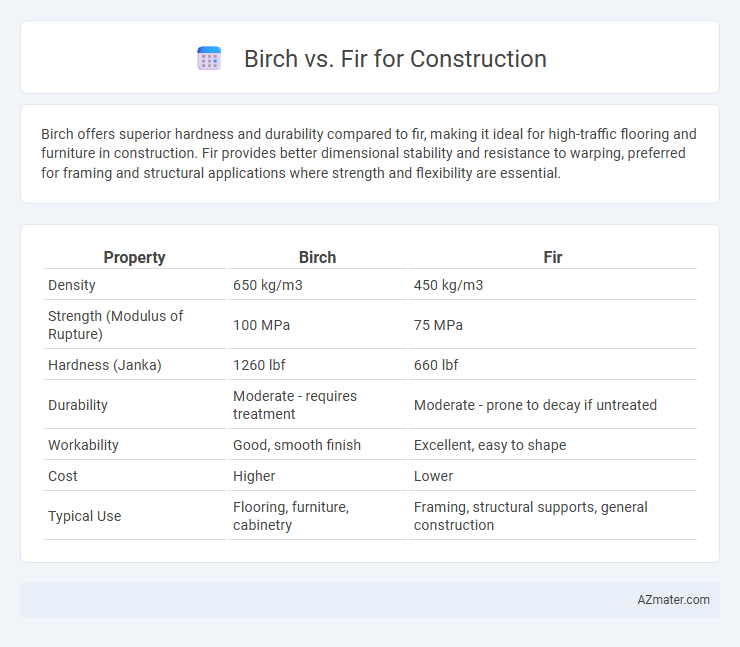Birch offers superior hardness and durability compared to fir, making it ideal for high-traffic flooring and furniture in construction. Fir provides better dimensional stability and resistance to warping, preferred for framing and structural applications where strength and flexibility are essential.
Table of Comparison
| Property | Birch | Fir |
|---|---|---|
| Density | 650 kg/m3 | 450 kg/m3 |
| Strength (Modulus of Rupture) | 100 MPa | 75 MPa |
| Hardness (Janka) | 1260 lbf | 660 lbf |
| Durability | Moderate - requires treatment | Moderate - prone to decay if untreated |
| Workability | Good, smooth finish | Excellent, easy to shape |
| Cost | Higher | Lower |
| Typical Use | Flooring, furniture, cabinetry | Framing, structural supports, general construction |
Overview of Birch and Fir in Construction
Birch wood offers high density and hardness, making it ideal for durable flooring and cabinetry in construction. Fir provides excellent structural strength and dimensional stability, commonly used for framing and support beams due to its straight grain and resistance to warping. Both woods contribute unique benefits, with birch favored for fine finishes and fir preferred for load-bearing applications.
Physical Properties Comparison
Birch exhibits higher density and hardness compared to fir, making it more resistant to wear and impact in construction applications. Fir, with its lower weight and moderate strength, offers better workability and ease of handling for framing and general carpentry. Moisture content and dimensional stability favor birch, providing enhanced durability and resistance to warping in structural uses.
Strength and Durability Analysis
Birch offers high strength with a Janka hardness ranging from 1260 to 1400 lbf, making it suitable for structural applications requiring hardness and wear resistance. Fir, particularly Douglas Fir, provides excellent durability and exceptional strength-to-weight ratio, with a bending strength of approximately 12,100 psi, ideal for framing and heavy construction. Both woods present strong options, but Fir's natural resistance to decay and insect damage often makes it preferable for outdoor and load-bearing construction projects.
Workability and Machinability
Birch wood offers excellent workability, characterized by its fine and even texture, making it easy to cut, sand, and shape with minimal splintering. Fir, while slightly softer than birch, provides good machinability but may require sharper tools to avoid tear-out during intricate detailing or milling processes. Both woods are favored in construction for their ability to hold nails and screws securely, but birch's smoother finish often results in a more refined appearance when used in cabinetry and interior elements.
Moisture Resistance and Decay
Birch wood has moderate moisture resistance but is more prone to decay when exposed to prolonged damp conditions, making it less ideal for outdoor construction without proper treatment. Fir, particularly Douglas fir, exhibits superior moisture resistance and natural durability, offering enhanced resistance to rot and decay in humid environments. For construction projects requiring durability against moisture, fir is generally the preferred choice due to its strength and longevity in wet conditions.
Cost and Availability
Birch wood generally has a higher cost compared to fir due to its denser grain and durability, making it ideal for premium construction projects where strength and aesthetics are prioritized. Fir is more widely available and affordable, especially in North America, making it a popular choice for large-scale construction and framing where budget constraints are critical. The availability of fir in larger dimensions and its ease of workability contribute to its cost-effectiveness and widespread use in structural applications.
Environmental Impact and Sustainability
Birch wood, known for its rapid growth and widespread availability, offers a lower environmental impact due to sustainable harvesting practices and its ability to regenerate quickly, making it an eco-friendly option for construction. Fir, while also renewable, grows slower and often requires more intensive forest management, which can increase its ecological footprint compared to birch. Both woods provide durable structural properties, but birch's faster growth cycle contributes to a more sustainable long-term resource for building materials.
Common Construction Applications
Birch wood, known for its fine grain and high strength, is commonly used in furniture making, cabinetry, and interior finishes due to its smooth surface and durability. Fir, particularly Douglas fir, is favored in structural applications such as framing, beams, and flooring because of its excellent load-bearing capacity and resistance to warping. Both woods are valued in construction, but birch is typically selected for aesthetic and detailed work, while fir is preferred for robustness and structural integrity.
Aesthetic Differences
Birch wood features a pale, creamy color with a fine, uniform grain that offers a sleek, modern appearance ideal for contemporary construction projects. Fir presents a warm, reddish-brown hue with pronounced grain patterns and knots, providing a rustic, natural charm suited for traditional or farmhouse-style buildings. Choosing between birch and fir hinges on the desired aesthetic impact, balancing birch's smooth elegance against fir's textured warmth.
Choosing the Right Wood for Your Project
Birch offers a fine grain and light color, making it ideal for interior projects requiring smooth finishes and aesthetic appeal, while fir provides excellent strength and durability, suited for structural applications such as framing and beams. Birch is moderately hard with good shock resistance, but fir's superior tensile strength and natural resistance to decay make it a preferred choice for exterior construction and load-bearing elements. Selecting between birch and fir depends on balancing aesthetic needs with structural requirements, ensuring the wood aligns with your project's durability, appearance, and environmental exposure demands.

Infographic: Birch vs Fir for Construction
 azmater.com
azmater.com